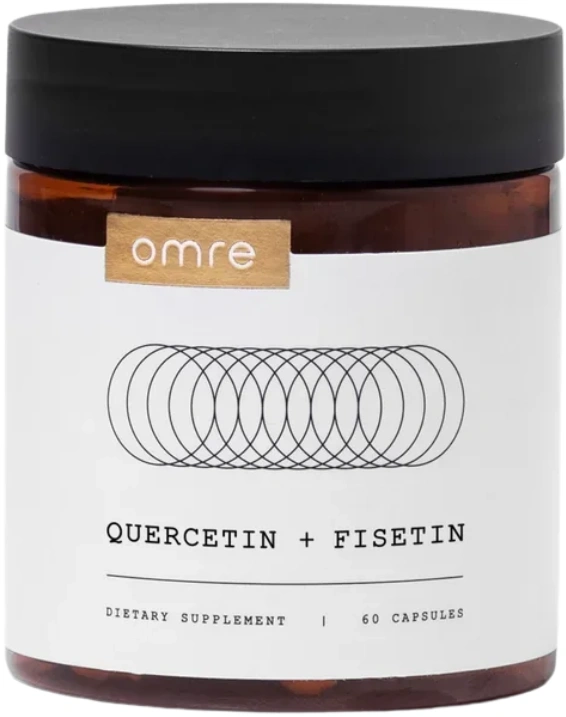Table of Contents
Some foods contain natural compounds that may help kill zombie cells, also known as senescent cells. These are damaged cells that no longer function properly but don’t die off like they should.
By eating foods rich in senolytics, compounds that help remove these lingering cells, you may support healthier aging and reduce the risk of age-related diseases.
Quercetin and Fisetin help manage 'zombie' senescent cell burden and support cellular rejuvenation.*Quercetin + Fisetin
TL;DR
Here’s a quick list of foods that contain compounds studied for their potential to clear senescent cells and support healthy aging:
Strawberries & berries – Rich in fisetin and anthocyanins
Apples & onions – High in quercetin, a natural senolytic
Green tea – Contains EGCG, supports autophagy
Broccoli & cruciferous veggies – Provide sulforaphane and kaempferol
Fatty fish – Packed with omega-3s that may lower inflammation and SASP
Dark chocolate – Flavanols support circulation and cell health
Turmeric – Curcumin may suppress senescence signals
Spinach – Contains lipoic acid to support mitochondrial health
Grapes – High in resveratrol for cellular repair
Ginger – Offers 6-shogaol and gingerenone A, potential senolytics
Long pepper – Contains piperlongumine, an emerging senolytic
Garlic – Allicin helps fight oxidative stress and inflammation
What Are Zombie Cells?
Zombie cells are damaged cells that stop dividing but don’t die. Instead, they stick around and trigger inflammation, aging, and chronic disease.
Also called senescent cells, these dysfunctional cells release harmful molecules that damage nearby healthy cells. This process is known as the senescence-associated secretory phenotype (SASP), which contributes to low-grade, chronic inflammation, often called "inflammaging."
As we age, our bodies naturally build up more of these zombie cells. Studies link high levels of senescent cells to diseases like heart disease, type 2 diabetes, arthritis, and even cancer (1).
In one study, mice lived longer and had fewer age-related conditions after researchers cleared their senescent cells (2).
Clearing out these cells doesn’t just slow aging, it may also improve physical function and boost tissue repair. That’s why senolytics, both in supplements and foods, are getting so much attention in the longevity space.
How Certain Foods Can Help Clear Senescent Cells
Some natural foods contain senolytic or senomorphic compounds. Senolytics help remove zombie cells, while senomorphics help reduce their harmful effects without killing them.
Compounds like fisetin, quercetin, curcumin, and sulforaphane have shown senolytic properties in lab and animal studies.
While these studies often use high doses in supplement form, eating a diet rich in these compounds may still support your body’s cleanup process over time.
By regularly eating foods that contain these nutrients, you're giving your body tools to slow cellular aging and reduce inflammation. It's not a quick fix, but it’s a smart long-term strategy.
Top 12 Foods That Kill Zombie Cells
 Here are the top foods known to contain senolytic or senomorphic compounds:
Here are the top foods known to contain senolytic or senomorphic compounds:
Strawberries and other berries
Apples and onions
Green tea
Broccoli and other cruciferous vegetables
Fatty fish like salmon
Dark chocolate
Turmeric
Spinach
Grapes
Ginger
Long pepper
Garlic
Now, let’s take a closer look at each of these foods and why they matter.
1. Strawberries and Other Berries
Berries are small but powerful when it comes to senescent cell support. Strawberries, in particular, are one of the richest dietary sources of fisetin, a plant compound that has shown strong senolytic activity in animal studies.
In one 2018 study, fisetin reduced the number of senescent cells in mice and extended their lifespan (3).
Blueberries, raspberries, and blackberries also contain quercetin and anthocyanins, which help reduce oxidative stress and may support cellular repair.
Add a handful of mixed berries to your breakfast or smoothie to tap into their anti-aging potential.
2. Apples and Onions
Both apples and onions are loaded with quercetin, a natural antioxidant that’s shown senolytic properties in lab studies.
Quercetin may help clear out senescent cells and lower the inflammation they cause. In some studies, it’s been paired with dasatinib to improve its effect in reducing zombie cells (4).
Apples also contain fisetin, especially in the skin. Keep the peel on when you snack or add slices to salads.
For onions, red varieties tend to have the highest quercetin content. Cook them lightly or enjoy them raw in salads for the biggest benefit.
3. Green Tea
Green tea contains EGCG (epigallocatechin gallate), a potent catechin that has been shown to promote autophagy, a process where your body clears out old and damaged cells.
In mouse studies, EGCG helped reduce the release of SASP, which in turn slowed the buildup of zombie cells (5).
Aside from EGCG, green tea is also packed with polyphenols that support healthy aging. Try drinking 2–3 cups a day. For variety, you can also try matcha, which contains a more concentrated dose of catechins.
4. Broccoli and Other Cruciferous Vegetables
Cruciferous vegetables like broccoli, kale, Brussels sprouts, and cauliflower contain sulforaphane, a powerful compound that helps activate detox enzymes and reduce inflammation.
Sulforaphane has been shown to trigger protective pathways that may reduce senescent cell buildup and improve cellular resilience (6).
These veggies also contain kaempferol, a flavonoid that may delay visible signs of aging by reducing oxidative damage and collagen loss.
Light steaming helps preserve sulforaphane while improving digestibility. Aim to include cruciferous veggies in your meals a few times a week.
5. Fatty Fish (Salmon, Mackerel, Sardines)
Fatty fish are rich in omega-3 fatty acids, which help reduce inflammation and may slow the production of senescent cells.
Studies suggest omega-3s can lower the activity of the SASP and even block the development of new zombie cells (7).
Salmon, sardines, and mackerel are great sources. Eating two servings of fatty fish per week not only supports brain and heart health but may also help your cells age more gracefully.
If you're vegetarian, flaxseed and chia seeds offer plant-based omega-3s, though in a slightly different form.
6. Dark Chocolate (70% or Higher Cocoa)
Good news for chocolate lovers: dark chocolate is packed with flavanols, a type of antioxidant that can help reduce inflammation and oxidative stress, two major drivers of senescence.
Early studies suggest flavanols may slow cellular aging and improve blood flow, supporting overall tissue health (8).
Look for dark chocolate that contains at least 70% cocoa for the most benefit.
A small square or two a day can be a smart, enjoyable way to support your body’s anti-aging efforts. Just keep sugar content low.
7. Turmeric
The active compound in turmeric, curcumin, is well-known for its anti-inflammatory and antioxidant effects.
Curcumin may help suppress pro-inflammatory signals released by zombie cells, and promote autophagy to help clear out cellular debris (9).
Turmeric pairs well with savory dishes, curries, and golden milk.
To boost curcumin absorption, combine it with a pinch of black pepper (which contains piperine) and a source of healthy fat like olive oil or coconut milk.
8. Spinach
Spinach is a leafy green loaded with nutrients and lipoic acid, a compound that supports mitochondrial health and may help damaged cells function more efficiently.
Lipoic acid works as a senomorphic agent, which means it can make zombie cells behave more like healthy ones (10).
Spinach also provides magnesium, folate, and antioxidants that support healthy cell turnover. Toss raw spinach into smoothies, steam it lightly, or sauté with garlic for a nutrient-packed side.
Quercetin + Fisetin
Quercetin and Fisetin help manage 'zombie' senescent cell burden and support cellular rejuvenation.*
9. Grapes
Grapes, especially red and purple varieties, contain resveratrol, a compound that’s been widely studied for its anti-aging effects.
Resveratrol may improve mitochondrial function and reduce inflammation, two factors involved in slowing senescent cell accumulation (11).
This compound is often concentrated in the skin of grapes, so eating them whole (not just the juice) provides the most benefit.
You can also find resveratrol in red wine, but whole grapes are a healthier daily option.
10. Ginger
Ginger contains bioactive compounds like gingerenone A and 6-shogaol, which may help eliminate zombie cells selectively.
Research suggests these compounds can stop the spread of cellular senescence and reduce oxidative stress (12).
Fresh ginger can be grated into teas, stir-fries, or dressings. It adds both flavor and health benefits, especially when consumed regularly in small amounts.
11. Long Pepper (Piper Longum)
Used in Ayurvedic and Southeast Asian cooking, long pepper contains piperlongumine, a compound gaining attention for its selective senolytic activity.
In lab studies, it was able to kill senescent cells while leaving healthy ones unharmed (13).
Long pepper has a bold, slightly sweet heat, similar to black pepper but more intense.
It’s available as a spice or supplement, though more human studies are needed to confirm its long-term effects.
12. Garlic
Garlic isn’t just heart-healthy, it’s also rich in allicin, a sulfur-containing compound with antioxidant and anti-inflammatory properties.
Allicin helps reduce oxidative stress, which may slow the formation of senescent cells and protect healthy tissue (14).
Crushing or chopping garlic activates allicin, so let it sit for 5–10 minutes before cooking. Add it to soups, roasted vegetables, or sauces to support your immune system and cellular health.
Lifestyle Habits That Help Clear Zombie Cells
 Food plays a big role, but your daily habits matter just as much. These three lifestyle changes may help your body manage senescent cells and support long-term health.
Food plays a big role, but your daily habits matter just as much. These three lifestyle changes may help your body manage senescent cells and support long-term health.
Intermittent Fasting
Intermittent fasting (IF) supports a process called autophagy, where your body clears out old or damaged cells and recycles them. This cleanup can indirectly reduce the buildup of zombie cells and improve cellular function.
A popular approach is the 16:8 method, eating within an 8-hour window and fasting for the remaining 16 hours.
One small study found that women who combined IF with moderate exercise showed a drop in mTOR, a key enzyme linked to cellular aging and senescence (15).
Exercise
Physical activity may help lower the number of senescent cells in tissues like muscle and fat. Regular exercise has been shown to inhibit genes that promote cellular senescence and inflammation.
Both aerobic and resistance training offer benefits, such as:
Brisk walking or hiking
Cycling or swimming
Strength training with weights
Bodyweight exercises like squats and push-ups
Yoga or Pilates for flexibility and balance
A study published in Cell Metabolism found that older adults who exercised regularly had fewer zombie cells and better mitochondrial function than sedentary peers (16).
Just 30 to 45 minutes a few times a week can make a real difference over time.
Mediterranean Diet
The Mediterranean diet is rich in anti-inflammatory foods like olive oil, leafy greens, fatty fish, and whole grains.
It's been linked to slower telomere shortening, lower oxidative stress, and less cellular aging.
In a clinical trial, people following a Mediterranean diet showed stronger resistance to age-related cellular decline compared to those on a standard low-fat diet (17).
Its mix of antioxidants, polyphenols, and healthy fats make it a great foundation for senescent cell management.
What About Supplements?
While food and lifestyle changes lay the foundation, supplements can offer targeted support. Some compounds, like quercetin and fisetin, are hard to get in meaningful amounts from diet alone. That’s where a well-formulated supplement can step in.
One standout option is Omre Quercetin + Fisetin, a doctor-developed formula designed to support your body’s natural ability to manage senescent cells.
Omre Quercetin + Fisetin: A Targeted Senolytic Blend
 As we age, senescent cells tend to build up, releasing inflammatory substances that speed up the aging process.
As we age, senescent cells tend to build up, releasing inflammatory substances that speed up the aging process.
Omre combines quercetin and fisetin, two plant-based senolytics that have been studied for their ability to clear these “zombie” cells and support healthier aging.
This formula isn’t just about the ingredients; it’s about making them work better. You get 500 mg of Quercetin Phytosome, a highly bioavailable form designed for improved absorption and cellular activity.
It also includes 100 mg of Fisetin at 98% purity, which supports your body’s natural clearance of senescent cells.
Unlike many generic blends, Omre uses clinically relevant doses based on current research, so you get the most from every capsule.
It's an easy addition to your daily wellness routine if you're serious about aging smarter.
Final Words
Zombie cells may be invisible, but their impact on your health is real.
By eating the right foods, staying active, and supporting your body with smart habits, you can help slow the aging process from the inside out.If you're looking for an added layer of support, Omre Quercetin + Fisetin offers a simple and science-backed way to promote healthy cell turnover.
Check availability and see if it fits your routine.
FAQs
What are the best foods to get rid of zombie cells naturally?
Foods rich in senolytic compounds like fisetin, quercetin, sulforaphane, and curcumin are your best bet. These include strawberries, apples, onions, green tea, broccoli, turmeric, and fatty fish. Eating a variety of these foods regularly can support your body’s natural cell cleanup processes.
Is there any proof that food can kill senescent cells?
Some lab and animal studies suggest that certain compounds found in foods, like fisetin and quercetin, can reduce the number of senescent cells. However, most of these effects were seen at high doses. While food alone may not “kill” these cells outright, a healthy diet can help slow their accumulation and reduce their harmful effects.
Can supplements work better than food for zombie cells?
Yes, in some cases. Supplements like Omre Quercetin + Fisetin deliver these compounds at higher, more bioavailable doses than you’d typically get from diet alone. They’re not a replacement for healthy eating, but they can complement it, especially if you’re targeting specific aging concerns.
How long does it take for senolytic foods to work?
There’s no quick fix. The effects of senolytic foods build over time as part of a consistent, healthy lifestyle. Think in terms of months, not days. Supporting your body daily with the right foods, movement, and habits is what makes the difference long-term.
Do I need to fast to kill zombie cells?
You don’t have to, but intermittent fasting may help. It supports autophagy, your body’s natural way of clearing out damaged cells, which includes senescent ones. Combining fasting with a nutrient-dense diet may give you even better results.





